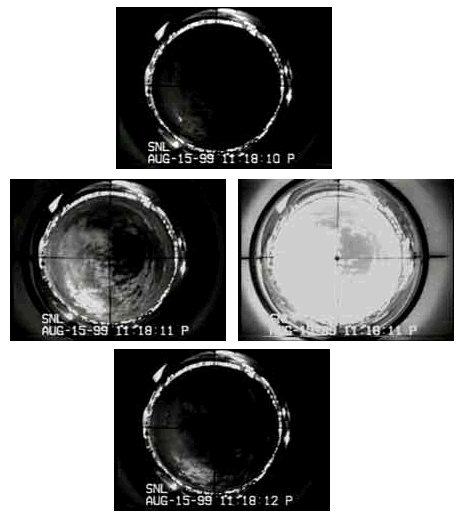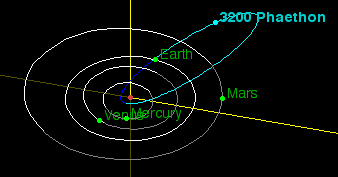
According to Sandia National Laboratories in Albuquerque, the following images are "... from a videotape of the August 15, 1999 meteor from an all-sky camera located at Sandia National Laboratories in Albuquerque. The camera views a spherical convex mirror that looks like a chrome hub-cap, which produces a fish-eye image of the entire sky. The horizon is ringed by city lights, and north is toward the upper left. The meteor appears to the west, in the lower left quadrant, and descends into the clouds as it lights up the entire sky. A radiometer indicates that the apparent magnitude peaked at about -16.5, which is about thirty times as bright as the full moon. Directly beneath the fireball it may have been 300 times as bright as the moon. Research has shown that meteoroids weighing roughly one ton get this bright when they enter the atmosphere. ...":

According to Sky and Telescope, the
occurs when Earth passes near the orbit of Comet 55P/Tempel-Tuttle. When the comet visits the inner solar system, the Leonid shower sometimes produces a veritable storm of meteors. This last occurred in 1966, when up to 40 meteors per second were seen for about an hour! Both 1998 and 1999 are good years to watch for a possible repeat of this performance. Best chances: the early morning hours of November 17 or 18, 1998, and November 18, 1999."
According to a 7 December 2001 Science@NASA web page:
"... Earth is [7 December 2001] entering the outskirts of a dusty debris cloud shed by a mysterious object named 3200 Phaethon. It's the beginning of the annual
which peaks this year [2001] on Dec. 13th and 14th. The two-week long Geminid shower is barely a trickle at the moment -- only 5 to 10 meteors per hour. But soon it will intensify ten-fold or more. You can catch the main event beginning just after sunset on Thursday, Dec. 13th. "When the Sun goes down on Thursday," says Bill Cooke of the NASA Marshall Space Flight Center, "Gemini will be low but rising over the eastern horizon [as viewed from mid-northern latitudes]. You won't see many meteors then, but the ones you do will likely be beautiful Earthgrazers" -- that is, disintegrating meteoroids that fly over the horizon nearly parallel to the atmosphere. Earthgrazers are long, bright and vivid. A remarkable sight. ... Gemini will continue to climb higher in the sky. "Around midnight go back outside," he suggests. "Gemini will lie almost directly overhead. From midnight until dawn on Friday, Dec. 14th, you could spot as many as 100 shooting stars per hour." ... Nowadays the Geminids are generally regarded as one of the best annual meteor showers. But it wasn't always so. ...
... The first Geminid shower suddenly appeared in 1862, surprising sky watchers who saw 15 or so shooting stars each hour.Astronomers immediately began looking for a comet. Most meteor showers result from debris that that boils off a comet when it passes close to the Sun. When Earth passes through the debris, we see a meteor shower. For more than a century astronomers searched in vain for the parent of the Geminids. Finally, in 1983, NASA's Infra-Red Astronomy Satellite (IRAS) spotted something. It was several-km wide and moved in much the same orbit as the Geminid meteoroids. Scientists named it 3200 Phaethon.
But rather than solving the puzzle of the Geminids parentage, the IRAS discovery simply deepened the mystery. Why? Because Phaethon appears to be an asteroid. Indeed it's cataloged as a potentially-hazardous one that skims by Earth's orbit only 8 times farther away than the Moon. Asteroids that spew debris into space like a comet are rare indeed, so astronomers were more baffled than ever.
Since then many sky watchers have come to regard the Geminids as a "weird" meteor shower -- the only one caused by an asteroid.
But maybe, says Cooke, it's not so weird after all. "I don't think the Geminids come from an asteroid. They're cometary ... just like all the other meteor showers. 3200 Phaethon is indeed the parent, but it's an extinct or dormant comet." According to Cooke, Phaethon probably looked much like other comets many centuries ago, with a fuzzy head and a glowing dusty tail. But this one was doomed to rapid extinction by its short-period sungrazing orbit. Every one and a half years Phaethon plunges sunward from the asteroid belt and swings by the Sun at a distance of 0.14 astronomical units -- closer even than the planet Mercury. Such near encounters with the Sun would have cooked Phaethon, vaporizing its ices and leaving behind a shell of asteroid-like dust and rock.
Such over-cooked comets may be abundant, says Mike A'Hearn (Univ. of Maryland), the principal investigator of NASA's Deep Impact mission. "Dynamical studies suggest that perhaps a few percent to 50% of all near-Earth objects are dormant or extinct comets masquerading as asteroids." From a distance there's no definitive way to tell the two apart. "Both comets and main belt asteroids are very dark," says Lucy McFadden (Univ. of Maryland), a member of the Deep Impact science team. "And we don't know of any robust chemical or spectral signature to absolutely identify a comet's nucleus." Indeed, she says, "even if we were to fly to Phaethon we might not be able to tell whether it is an extinct comet" without somehow looking beneath its crust. ...".
According to a 11 December 2000 Science@NASA web page: "... Every year in mid-December when the Geminid meteor shower is active, Earth is barely eight lunar distances (~0.021 AU) from Phaethon's orbit. That makes Phaethon a "potentially hazardous" near-Earth asteroid (NEA). ...
... In July 1996 astronomers saw something in the asteroid belt that could be relevant to the past experiences of 3200 Phaethon. "Four years ago Eric Elst contacted us from the European Southern Observatory and reported a strange object (now known as 'Elst-Pizarro' after its discoverers)," recalled Marsden. "It had a tail, like a comet, but no coma. We calculated an orbit and it seemed to be a perfectly ordinary minor planet in the asteroid belt. Furthermore, we found some older images of it from 1979 and '85. There was no tail in those photos and by 1997 the tail Elst saw a year earlier was gone." ... says Marsden. "We may have been seeing a cloud of dust that was ejected by an impact with another asteroid or, perhaps, a small ice deposit became uncovered and vaporized." ...
... A collision between Phaethon and some smaller object in the asteroid belt might account for the Geminid debris stream. ... The debris trail seems to be spread rather uniformly around Phaethon's orbit -
[ a JPL Java applet web page shows the orbit of Phaethon

as of 14 December 2001 ]
- another indicator that the meteoroids are old. ...".
According to a 29 March 2000 article on the Space.com website by Robery Roy Britt and Mary Motta: "... in the early 1970s ... Chuck Bonner and his playmates heard a loud, abnormal whistling noise accompanied by a buzz. ... they spotted a green fireball as large as a full moon streaking across the sky. Ever since, Bonner ... has wondered how he could have heard the apparent meteor before he saw it, since sound travels much slower than light. ... There are only a handful of "earwitness" accounts of these melodious symphonies in the sky. One account from China in 817 AD tells of a noise "like a flock of cranes in flight." A common and curious thread in these tales is that the sound seems to travel at the speed of light ... Australian researcher Colin Keay ... developed in the early 1980s ... the theory ... [that]... when a space rock plunges earthward, friction caused by the atmosphere creates a trail of electrically charged particles, or plasma, in which Earth's invisible but potent magnetic field lines become trapped, tangled and twisted like strings of cooked spaghetti. This magnetic spaghetti is thought to generate very low frequency radio waves, says Keay ... The waves are thought to travel at the speed of light and are converted into sound when they interact near the ground with what are called "dielectric media" or "transducers," which can be massive ordinary objects or electrical activity in the lower atmosphere. ...".
Colin Keay says, in a web article: "... the transfer of energy from a meteor fireball (bolide) to create the anomalous sounds had to be by means of electromagnetic radiation ... in nuclear explosions ... an intense burst of radio emission is produced of sufficient intensity to burn out electronic equipment. Reportedly it may be heard as a "click" by soldiers in bunkers near such a blast. ... What if the Earth's magnetic field was ... trapped in the turbulent plasma trail behind the bolide, and released when the plasma cooled and the ionisation neutralised itself? Calculations indicated that such a "magnetic spaghetti" could arise in a turbulent bolide trail. Turbulent conditions only exist when the trail is below a certain height in the atmosphere. And for the effect to be sustained for up to ten or more seconds the bolide must arrive in a shallow trajectory. These restrictions provide the underlying basis for Astapovich's empirical conclusions many decades ago that only bolides in low trajectories give rise to reports of electrophonic sounds. ... V.A. Bronshten ... endorsed the concepts in his treatise Physics of Meteoric Phenomena, and in a paper expanding my calculations he showed that a bolide twice as bright as a full moon could generate well over a megawatt of radio power by my "magnetic spaghetti" process. .... At Nagoya University Dr T Watanabe showed me ... his VLF chart recording, a radio spectrogram by Dr T Okada and the photometry from a carefully timed fireball photograph obtained by K Suzuki and his students. ... Observational proof that large meteors may produce audio frequency electromagnetic radiation has given vital support to the concepts ... the majority of bodies large enough to produce sustained electrophonic sounds by travelling in shallow trajectories are of stony composition, and an estimated 16,000 occur every year over the entire surface of the Earth. These are closely followed in numbers by the more readily fragmenting carbonaceous chondrites at 12,000 per year. Then there are the very fragile bodies of cometary composition at 4,600 per year, and lastly the fluffy very low density bodies also of cometary origin which come in at the rate of 1,300 per year. ... at any given location a nighttime electrophonic fireball may be expected about once every two or three years. However it is found that only between four and eight percent of witnesses of large fireballs actually hear the electrophonic sounds while the others hear nothing apart from the acoustically propagated sonic booms and rumbles arriving minutes later. ... One or two people in a group may hear the sounds while others do not. Or one entire group may report the sounds while other people in less favourable surroundings hear nothing. ... ".
......